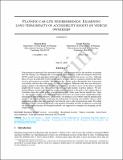Planning car-lite neighborhoods: Examining long-term impacts of accessibility boosts on vehicle ownership
Author(s)
Basu, Rounaq; Ferreira Jr, Joseph
DownloadTRD_2020_CarLiteScenario_Preprint.pdf (4.324Mb)
Publisher with Creative Commons License
Publisher with Creative Commons License
Creative Commons Attribution
Terms of use
Metadata
Show full item recordAbstract
Transformative technologies like automated vehicles, and emerging services like mobility-on-demand and ride-sharing, are changing the ecosystem of urban mobility. Land use-transport interaction (LUTI) models provide appropriate platforms to test the impacts of such services on cities. Although these services are purported to have mixed effects on cities, there is a general consensus that these services will increase accessibility. We approach the ‘car-lite’ policy through this lens of increased accessibility, and base this study in the city-state of Singapore. Different study areas are chosen in a manner similar to the differences-in-differences approach, in order to tease out the effects of initial neighborhood vacancy rate, vehicle-free behavior, and tight markets on policy impacts. We also design different scenarios that represent varying market reactions to the policy, and compare them to a baseline where the car-lite policy is never implemented. Study areas that are initially less ‘tight’ (i.e., have higher vacancy rates and lower vehicle-free rates) are found to have significantly larger transitions to vehicle-free behavior. Additionally, our finding of accessibility-induced gentrification speaks to the importance of considering the endogeneity in housing and mobility choices while formulating policies that may seemingly feel relevant only to the transportation realm. Providing appropriate mixes of housing typologies with adequate affordable housing, in addition to restricting car use for higher-income car-owning households, are suggested as strategies for designing car-lite neighborhoods.
Date issued
2020-06Department
Massachusetts Institute of Technology. Department of Urban Studies and PlanningJournal
Transportation Research Part D: Transport and Environment
Publisher
Elsevier BV
Citation
Basu, Rounaq and JosephFerreira. "Planning car-lite neighborhoods: Examining long-term impacts of accessibility boosts on vehicle ownership." Transportation Research Part D: Transport and Environment 86 (September 2020): 102394 © 2020 Elsevier Ltd
Version: Author's final manuscript
ISSN
1361-9209